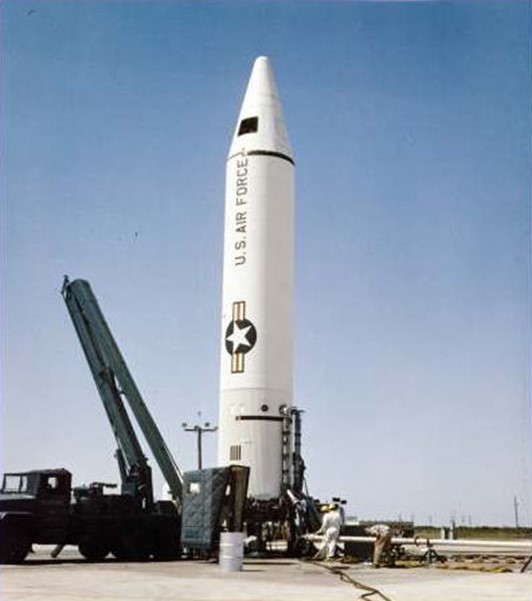JUPITER FACT SHEET
By Cliff Lethbridge

Jupiter On Launch Pad, Photo Courtesy U.S Air Force
Classification: Intermediate-Range Ballistic Missile
Length: 60 feet, 1 inch
Diameter: 8 feet, 9 inches
Range: 1,976 miles
Date of First Cape Canaveral Launch: March 1, 1957
Date of Final Cape Canaveral Launch: January 22, 1963
Number of Cape Canaveral Launches: 36
Designed by the Army Ballistic Missile Agency (ABMA), the Jupiter missile, initially designated SM-78, represented a logical follow-up to the Redstone MRBM. Even though research and development of the Jupiter was performed by the ABMA, the U.S. Army was never able to deploy the missile. Late in 1955, Secretary of Defense Charles E. Wilson directed the ABMA to work in conjunction with the U.S. Navy to develop both a land-based and sea-based version of the Jupiter. Just one year later, in his infamous “Wilson Memorandum”, Wilson stunned the ABMA by stripping the U.S. Army of all missiles with a range of over 200 miles. The U.S. Navy subsequently abandoned the Jupiter in favor of the safer, more practical solid-fueled, submarine-based Polaris missile.
The Jupiter was transferred to the U.S. Air Force. Although it eventually became the first operational U.S. IRBM, the Jupiter was never given tremendous attention by the U.S. Air Force. The missile had competed directly with the U.S. Air Force-developed Thor IRBM. The U.S. Army-developed Jupiter had been a source of bitter rivalry between the two branches of service since its conception. Built by Chrysler, the Jupiter first stage was powered by a Rocketdyne engine which burned liquid oxygen/RP-1 (kerosene) liquid fuel and could produce a thrust of 150,000 pounds at liftoff.
The first stage engine’s gimbaled thrust chamber was adapted directly from the canceled Navaho cruise missile. Vernier thrust and roll were controlled by the gimbaled first stage engine exhaust. Missile guidance was provided by an ABMA-designed gyroscope and accelerometer built by Ford Instrument, Farragut and Sperry Gyroscope divisions of Sperry Rand. An ablative technology re-entry vehicle manufactured by Goodyear shrouded a one megaton warhead, and separated from the Jupiter following the detonation of explosive bolts. A Thiokol solid-fueled motor was ignited to provide final velocity trimming. Operational Jupiter missiles were delivered to the U.S. Air Force at a frequency of about four per month beginning in November, 1957. These could be moved during field operations inside a transporter which resembled a large steel tube. The transporter was towed by a six-by-six truck. The missile could be raised by a hoist and held upright for long periods by an A-frame support structure.
The missile itself remained shrouded by several “petal” hinges which provided environmental protection and could be “peeled” back prior to launch operations. Jupiter components were test flown aboard Jupiter A and Jupiter C rockets, which were not themselves Jupiters but rather modified versions of the Redstone MRBM. The first test flight of an actual Jupiter missile occurred on April 26, 1957. In 1958, the U.S. Air Force activated the 864th and 865th Strategic Missile Squadron at the Redstone Arsenal in Huntsville, Alabama, where the Jupiter missile was designed. Jupiter missiles were subsequently deployed by NATO troops in Italy and Turkey under U.S. supervision. The Jupiter IRBM was withdrawn from service in 1964.
Although apparently short-lived, the Jupiter program played a vital role in the history of the U.S. space program. Development of the Jupiter missile led directly to the launch of America’s first satellite aboard a Juno I rocket. The Juno I was adapted from the Redstone-based Jupiter C vehicles used to test Jupiter components. There was also a chance that the Jupiter missile itself could have played an important role in the NASA Mercury program. In December, 1958 Mercury program managers asked ABMA to complete a feasibility analysis on how Redstone and Jupiter missiles could be modified for use in meeting Mercury test objectives. Indeed, ABMA quickly designed specific modifications for both Redstone and Jupiter missiles that would allow the missiles to carry Mercury capsules. The Redstone design became known as the Mercury-Redstone, but it is lesser known that a Mercury-Jupiter design also emerged.
But, the vehicle never left the drawing board as NASA canceled the Mercury-Jupiter program in July, 1959. It had become clear by that time that Mercury-Redstone and Mercury-Atlas rockets would be sufficient to support Mercury test objectives. The Jupiter missile did, however, act as the first stage for the Juno II rockets which carried a number of scientific payloads into space. Juno II, in turn, was an ancestor of the rockets which would carry men to the Moon. And even if spurned during the NASA Mercury program, the Jupiter missile was actually able to play a role in the NASA Apollo program. Inert Jupiter missile shells ballasted with water were used as dummy upper stages for the earliest version of the Apollo-Saturn I, known as the Saturn I Block I.


